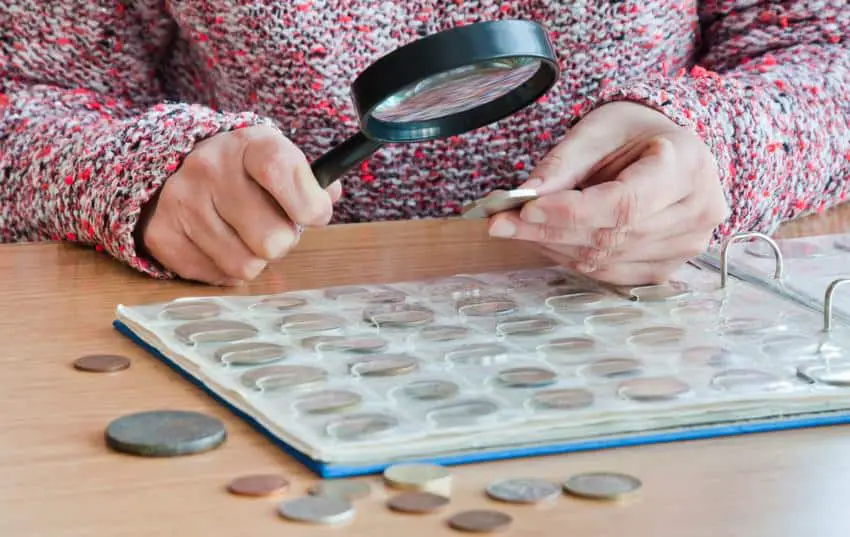
As your coin collection grows, you’ve got some decisions to make on organizing them properly. The difference between a serious collector and a person with a bunch of coins laying around is mainly about organization …
… So, how to organize a coin collection? Start by acquiring some tools (a folder for example) where you can put your coins, then depending on what coins you already have choose the best way to categorize them (by date, value, rarity, country …).
Don’t let decisions about organizing your coins stress you out—there are plenty of good options. Just pick a system, get started and do adjustments as you go…
… Indeed, you can always modify your coin organization over time as your preferences and/or collection changes.
Why is organizing a coin collection so important?
Organizing your collection can help you in so many different ways, including:
- Keeping your coins safe (maintaining their condition)
- Knowing what coins you have
- Being able to access specific coins easily
- Showing you what coins to try and acquire
- Managing the space your collection takes up
The bottom line is, you’ll likely get much more enjoyment and value out of an organized collection!
You’ll be able to instantly locate a coin you want to sell or show someone. You can peruse through the coins you own to admire the completeness of your collection or set goals for your next few acquisitions.
While this hobby can be quite enjoyable, you don’t want it to rule your life by taking up every inch of your living space!
Organizational tools allow you to contain your collection safely so you can enjoy it without stumbling over it constantly. Trust me, the other people (and even pets) in your life will thank you as well!
Finally, because coins are meant to be kept for extended periods of time, if you ever want to pass your collection along to a future generation, they will get much more benefit from it if the collection has been kept organized.
Tools needed to organize your coins
To organize your coins, you will need the right tools for storage as well as cataloging your collection.
There are plenty of sources for high-quality coin collecting tools. Let’s review the options so you can select what works best for you and your budget:
1. Storage tools
Typically, collectors will use a variety of storage options with the most expensive and protective options reserved for their highest value coins.
- Tubes (Check it Here at Amazon): plastic tubes for storing large quantities of coins together in stacks
- 2 x 2s: cardboard sleeves (2-inch square) with circular cutouts for your coins; can be labeled with information and stored in albums or boxes
- Folders (Check it Here at Amazon) : books with cardboard pages that have circular insets for your coins; often made for specific series
- Albums (Check it Here at Amazon): like photo albums but with plastic sleeves for holding 2 x 2s with your coins
- Capsules (Check it Here at Amazon): hard plastic cases meant for protecting high-value coins
- Boxes: used for holding quantities of 2 x 2s, tubes, or coin capsules; there are display quality or cardboard varieties
To learn more tips on how you can protect your collectibles in general, you should check this guide to protect your collectibles!
2. Cataloging tools
Don’t neglect the all-important step of making an inventory of your collection. Your inventory will contain a record of each coin you own.
This record is important not only for insurance purposes, but also to help you understand the breadth of your collection and where you want to go with it.
Options for cataloguing your coin collection include:
- Binder with pages
- Coin inventory book
- Spreadsheet software such as Microsoft Excel
- Specialized coin software or app
Beginners with smaller collections may find a pen and paper method the most straightforward, whereas those amassing larger collections will likely benefit from using an electronic spreadsheet or coin tracking software.
Regardless of whether you go the old-fashioned route or use an electronic cataloging method, your records should contain the following minimum set of information:
- Country
- Year
- Denomination
- Mintmark
- Grade
- Date of purchase
- Purchase price
Tips to better organize your coins!
It has been said that there are as many ways to organize a coin collection as there are collectors. I’ll share here some common and unique ways to do it along with some additional tips.
Please know that you can combine coin organization methods or come up with your own entirely. The important part or your organization system is that it makes sense to you.
1. Organize by country of origin
World coin collectors will do well to group their coins by country. Once you’ve sorted by country, you can either alphabetize your categories by country (Canada, China, UK, etc.) or sort the countries into larger regions (Asia, South America, etc.).
Within country categories, you can choose a secondary method of organization, such as those below, to further organize your coins.
2. Organize by denomination and coin type
It can be helpful to group your coins by denomination, such as all your half-dollars together, dimes, etc. You can also get more specific and have albums, tubes, or folders for individual coin types, such as Roosevelt dimes or Indian head pennies.
Many commercial folders and albums help with this type of organization because they can be purchased for a specific coin type. You might buy a state quarters folder, and it would have a cut-out for each one minted in a particular order (often by date).
3. Organize by mint year
Year is a common secondary method of organization, often going from oldest to newest coins in folders, albums, or other storage methods. As you review your collection, you’ll take a walk through history and be able to easily see any gaps in what you own.
You can also have albums for specific time periods, such as decades or pre-1950 and post-1950. The way you divide up the time periods will really depend on your specific collection.
4. Organize alphabetically
Alphabetical organization just makes sense to some people. If you’re a bibliophile at heart, you may naturally lean towards alphabetizing your coin collection.
With this method, Kennedy half-dollars could go under “K,” Roosevelt dimes under “R,” and so on.
Again, it’s all about what’s easiest for you. Using this method, your coin albums would be organized like a dictionary or encyclopedia.
5. Organize by historical periods
For the real history buffs out there, it can be fun to organize coins by historical periods, such as US presidential eras, war times, or other major historical events. In this way, you can tell a story about what was happening when each coin was minted.
Historical organization puts the coins into a broader context and can help their significance shine through.
6. Organize by value
It is best to store high-value coins separately from the rest of your collection. They will likely merit a more extensive storage method, like a capsule, that takes up more space for an individual coin.
Rather than store them in an album or folder with many other coins, they can be stored with your other high-value coins in a secure location under optimal conditions.
Keep in mind that coins tend to increase in value over time!
7. Leave gaps in your albums or folders
Don’t forget to leave spaces in your albums or folders for coins you still want to acquire. You can use checklists to see whether you have specific coins missing in a series.
When you identify gaps, leave a blank space in your album or folder if you plan to try and purchase that coin in the future.
This way, you won’t have to rearrange your whole album or folder each time you purchase a new coin. This is not as important for methods of storage that are not albums or folders with individual slots in an order.
8. Keep meticulous records
Finally, as we’ve discussed, you absolutely need to know what coins you’ve got in your collection.
You don’t want to waste time and money and accidentally purchase a duplicate coin, all because you did not keep good records.
Your cataloging efforts will also help you know when you’re making a good decision on a sale of one of the coins from your collection, because you’ll be able to see the original purchase price.
Mistakes to avoid!
The biggest mistakes to avoid are using improper materials for coin storage. Certain paper, cardboard, glues, and clear plastics made of PVC can all damage coins over time, causing discoloration or corrosion.
Therefore, you should always make sure to use acid-free archival quality materials when organizing your coins.
You don’t want to find your method of organization has caused damage to your investment many years down the road.
Should you put your collectible coins in a jar?
A glass jar is not the best option for storing your coins. For one, they will just sit in an unorganized pile inside the jar, and you’ll have to shake it around, dump out the contents, or finger through the coins to remove the one you’re looking for.
This method is not only disorganized, but it can also risk damaging your coins!
Additionally, air will circulate around your coins, and humidity along with chemicals or other impurities in the air can damage them over time.
There are many better options for coin storage, as reviewed already in this article.
Final Thoughts: Have fun!
Organizing your coin collection shouldn’t be a chore!
It can actually be an enjoyable part of the hobby if you find an organization method that comes easily to you.
Plus, just think of all the benefits you’ll be gaining from having an organized collection to enjoy and grow!
Finally, I highly encourage you to learn the right coin collecting process. This will help you get started on the right tracks!
